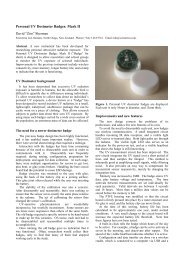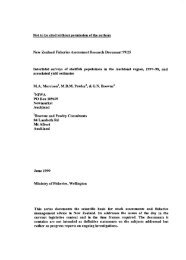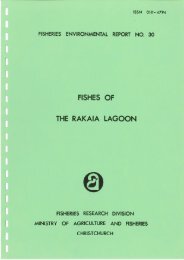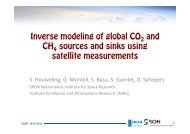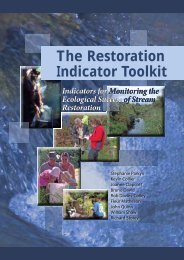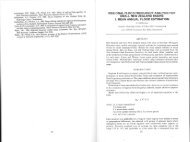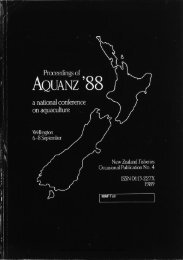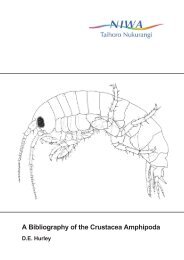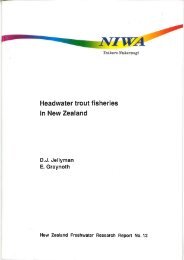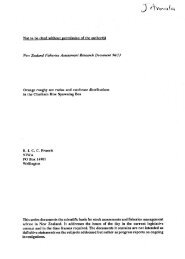WATER & SOIL - These are not the droids you are looking for.
WATER & SOIL - These are not the droids you are looking for.
WATER & SOIL - These are not the droids you are looking for.
Create successful ePaper yourself
Turn your PDF publications into a flip-book with our unique Google optimized e-Paper software.
The liequency factor K is a function of <strong>the</strong> coefficient of<br />
skew and <strong>the</strong> return period and may be obtained from<br />
tables (e.g., Harter 1969; USWRC 1967). The <strong>for</strong>m of<br />
Equation 4.5, which is based on <strong>the</strong> use of a frequency factor,<br />
is preferred to <strong>the</strong> more <strong>for</strong>mal type of LP3 equation<br />
(e.g., Equation A.3) <strong>for</strong> <strong>the</strong> method of moments fitting<br />
technique, as it makes <strong>the</strong> computations very much easier.<br />
The frequency factor idea has heen propounded by Foster<br />
(1924) and Chow (1951), and <strong>the</strong> derivation of <strong>the</strong> factor<br />
<strong>for</strong> <strong>the</strong> LP3 distribution is explained by NERC (1975, pp.<br />
39-40) and Kite (1976, pp. 198-204,2291.<br />
Method 2 This method is <strong>the</strong> same as Method l, except<br />
that an adjustment is made to <strong>the</strong> computed skew coefficient.<br />
An adjustment is warranted because <strong>the</strong> computed<br />
skew value is likely to be unreliable <strong>for</strong> a data sample of<br />
typical size. Indeed, it has been suggested (Beard and Frederick<br />
1975) that at least 100 sample items <strong>are</strong> needed to obtain<br />
a skew value that is representative of <strong>the</strong> population<br />
statistic. Since most hydrological data samples <strong>are</strong> much<br />
smaller than this, various ef<strong>for</strong>ts have been made to improve<br />
<strong>the</strong> reliability of <strong>the</strong> computed skew value through<br />
<strong>the</strong> use of generalised skew coeflficients (Beard 1977). One<br />
example is <strong>the</strong> use of a regional skew value taken from isolines<br />
of computed skew values.<br />
ln <strong>the</strong> early stages of this New Zealand study, computed<br />
skew values lbr flow stations in <strong>the</strong> top half of <strong>the</strong> South<br />
Island were plotted on a map to determine if <strong>the</strong>re was any<br />
pattern in <strong>the</strong> skew coefficient. None was evident and,<br />
hence, <strong>the</strong> possibility of using generalised skew coefficients<br />
in this study was <strong>not</strong> pursued. Instead, <strong>the</strong> following tactor<br />
Fu, recommended by Bobée and Robitaille (1975), was used<br />
to adlust <strong>for</strong> <strong>the</strong> bias in <strong>the</strong> skew value that is due to <strong>the</strong><br />
length of <strong>the</strong> data sample.<br />
Fo=<br />
where CS = <strong>the</strong> computed skew coefficient, and<br />
n : <strong>the</strong> number of sample items.<br />
The adjustment is made by multiplying <strong>the</strong> computed<br />
skew coefficient by Fu, but only when Equation 4.6 is<br />
applicable i.e., <strong>for</strong> samples with 20 or more items.<br />
Mefhod 3 This method is often referred to as <strong>the</strong> log-<br />
Normal method and uses <strong>the</strong> two-parameter log-Normal<br />
distribution, as distinct from <strong>the</strong> three-parameter one (see<br />
Kite 1976). The method has long been advocated <strong>for</strong> use in<br />
hydrological frequency analysis (e.g., Hazen l9t4), and appeals<br />
because of its simplicity <strong>the</strong> fitted frequency distribution<br />
plots -<br />
as a straight line on log-Normal probability<br />
paper.<br />
The application of <strong>the</strong> method involves <strong>the</strong> same computations<br />
as <strong>for</strong> Method l, except that <strong>the</strong> coefficient of skew<br />
of <strong>the</strong> logarithms of <strong>the</strong> series is set to zero.<br />
Method 4 This uses <strong>the</strong> maximum likelihood (ML)<br />
method to fit <strong>the</strong> CEV distribution to a data sample. This<br />
method of fitting is generally recognised as <strong>the</strong> most efficient<br />
<strong>for</strong> estimating <strong>the</strong> distribution parameters, and its use is<br />
recommended when <strong>the</strong> design events must be extracted<br />
from a small or irregular series (WMO 1969). However, <strong>the</strong><br />
ML method involves equations that have no explicit solution.<br />
The solution is complex and requires <strong>the</strong> use of an<br />
iterative numerical scheme, and is only worthwhile attempting<br />
with <strong>the</strong> aid of a computer.<br />
Method 5 Although <strong>the</strong> GEV distribution incorporates<br />
EVI as a special case, only r<strong>are</strong>ly will <strong>the</strong> application of<br />
Method 4 result in <strong>the</strong> EVI distribution being fitted to a<br />
data sample. To ensure that a fit was obtained with <strong>the</strong> EVI<br />
distribution, this distribution was fitted separately (by <strong>the</strong><br />
ML method) to <strong>the</strong> sample by setting <strong>the</strong> shape parameter k<br />
in <strong>the</strong> CEV distribution to zero.<br />
88<br />
¡ 16-11- *ry i.i,*<br />
.Tì"... ou<br />
Method ó This method is often called <strong>the</strong> "Gumbel<br />
method" after Gumbel (1941, 1954) and is probably <strong>the</strong><br />
one most commonly employed in hydrology. lt has had<br />
wide use in New Zealand and was <strong>the</strong> method adopted by<br />
<strong>the</strong> New Zealand Meteorological Service (Robertson l9ó3)<br />
when determining rainfall depth-duration-f'requency relationships<br />
from New Zealand data.<br />
Melhod 7 This method follows <strong>the</strong> procedure devised by<br />
Jenkinson (1955, 1969) and also described by Samuelsson<br />
(1972). The method emphasises <strong>the</strong> extreme part of annual<br />
series and as shown by Samuelsson, it can be applied as <strong>the</strong><br />
standard one to extreme values which belong to several different<br />
kinds of frequency distribution. A larger series of<br />
S-year maxima is produced from <strong>the</strong> annual series by considering<br />
all possible combinations of items of five in <strong>the</strong><br />
original series. The EVI distribution is <strong>the</strong>n fittcd to rhe<br />
series of 5-year maxima by <strong>the</strong> ML method.<br />
If an annual series is used in a lrequency analysis instead<br />
of a series of 5-year maxima, it is quite possible that <strong>the</strong><br />
series may be non-homogeneous in that, <strong>for</strong> example, <strong>the</strong><br />
smaller items may belong to one distribution (e.g., EV2)<br />
and <strong>the</strong> larger ones to a<strong>not</strong>her (e.g., EV3). Fur<strong>the</strong>r, it can<br />
be shown ma<strong>the</strong>matically (WMO 1969) that <strong>the</strong> lower parr<br />
(37V0) of <strong>the</strong> series may <strong>not</strong> even belong to <strong>the</strong> extreme<br />
value distribution as it is defined. The advantage of <strong>the</strong> Jenkinson<br />
method is that it generally overcornes this problem<br />
of non-homogeneity of data. The use of 5-year maxima can<br />
be thought of an increasing by fivefold <strong>the</strong> degree ol independence<br />
in <strong>the</strong> data, so that <strong>the</strong>se maxinra should <strong>the</strong>n<br />
<strong>for</strong>m a homogeneous set of data that confbrms to EV<br />
<strong>the</strong>ory.<br />
4.4 Evaluation of <strong>the</strong> frequency analys¡s<br />
methods<br />
4.4.1 General<br />
Prior to <strong>the</strong> development of <strong>the</strong> regional curves, two<br />
evaluation tests were carried out on 42 flood records altoge<strong>the</strong>r,<br />
using <strong>the</strong> seven frequency analysis methods described<br />
in section 4.3 and contained in <strong>the</strong> computer program<br />
FRAN. The purpose of <strong>the</strong> tests was twofold:<br />
(¡) to observe, and to indicate to users of FRAN, <strong>the</strong> relative<br />
merits of <strong>the</strong> seven different methods on individual<br />
New Zealand flood records;<br />
(ii) to assist in <strong>the</strong> selection of a frequency distribution<br />
that would adequately describe <strong>the</strong> regional curves.<br />
This section describes <strong>the</strong> tests and discusses <strong>the</strong> results<br />
obtained.<br />
4.4.2 Evaluation criteria and method<br />
Most studies that have attempted to discriminate between<br />
frequency analysis methods have relied, at least to some extent,<br />
on objective goodness-of-fit indices. Recent examples<br />
of such studies <strong>are</strong> those carried out by Benson (1968),<br />
Beard (1974), Kite (1976) NERC (t975), Kopiuke ef ø/.<br />
(1976) and Bobée and Robitaille (1977). However, as is generally<br />
acknowledged (e.g., Benson 1968), <strong>the</strong> classical<br />
goodness-of-fit indices such as Chi-squ<strong>are</strong> and Kolmogorov-Smirnov<br />
<strong>are</strong> <strong>not</strong> sufficiently sensitive or powerful<br />
enough, because of <strong>the</strong> small samples found in hydrology,<br />
to distinguish between <strong>the</strong> worth of different frequency analysis<br />
methods. Moreover, NERC (1975) found that o<strong>the</strong>r<br />
goodness-oi-fit indices had major weaknesses and concluded<br />
that, because of <strong>the</strong> deficiencies ol goodness-of-fìt<br />
indices, a visual inspection must be made of <strong>the</strong> probability<br />
plots. The judgement on <strong>the</strong> per<strong>for</strong>mance of a method is<br />
<strong>the</strong>n a subjective one, "... but <strong>the</strong> objective tests that <strong>are</strong><br />
available <strong>are</strong> so ineffective that <strong>the</strong>ir objectivity alone is insufficient<br />
to recommend <strong>the</strong>m" (NERC 1975).<br />
In <strong>the</strong> evaluation tests, much more emphasis was placed<br />
on <strong>the</strong> probability plots than on <strong>the</strong> Chi-squ<strong>are</strong> value,<br />
which <strong>the</strong> computer program calculated. F-ollowing an ex-<br />
Water & soil technical publication no. 20 (1982)



